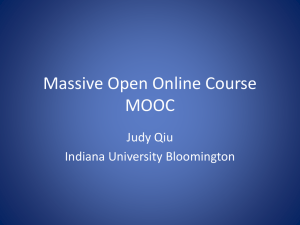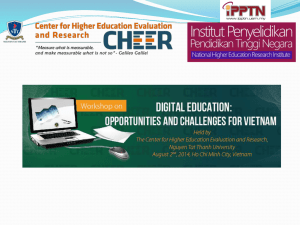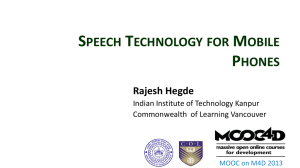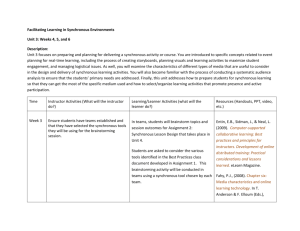Lessons learnt from online synchronous teaching in a language
advertisement
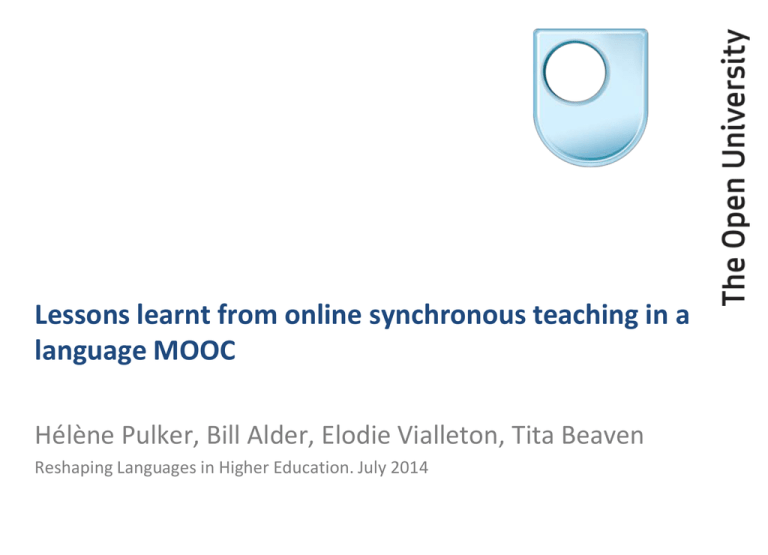
Lessons learnt from online synchronous teaching in a language MOOC Hélène Pulker, Bill Alder, Elodie Vialleton, Tita Beaven Reshaping Languages in Higher Education. July 2014 The MOOC Travailler en français The Travailler en français MOOC • The first ever French-as-a-foreign-language teaching MOOC (Vaufrey, 2013) • 4 Instituts Français and The Open University • 15 January to 15 March 2014 • Focus on French for employability • Pitched at CEFR level B1 Principles Cormier (2010) • Cormier (2010): ‘A MOOC is a course […]. It has facilitators, course materials, it has a start and an end date, it has participants […] It is, maybe most importantly, an event, around which people who care about a topic can get together and work and talk about it in a structured way.’ tools selected to fit constructivist principles (esp. forums and teleconferencing) • Also a task-based MOOC (Lane, 2012), where ‘community is crucial […] but it is a secondary goal’. a level of instructivism Users (15 Nov to 15 March) • • • • • • About 1,200 officially registered students by 15 January 102 students requested a completion certificate 12,543 unique website users over 4 months Average of 156 users / 192 sessions per day 23,265 sessions 50% of new visitors did not go past the first page (bounce rate) • On average: 3 page views per session Location of participants Location of participants: top 10 countries Brazil 147 Greece 171 Algeria 174 Germany 301 United States 334 Morocco 483 United Kingdom 682 Italy 964 France 3285 Spain 3737 0 500 1000 1500 2000 2500 3000 3500 4000 Tools • • • • • • • • Main platform: a google site Reference documents: google docs / google drive Questionnaires: google surveys Synchronous events: Blackboard Collaborate (recordings posted on vimeo) Asynchronous forum discussions: weebly Audio podcasts: soundcloud Social networking (promotion): facebook and twitter External resources (e.g. videos, links to websites) MOOC structure • An introduction week • 5 thematic weeks : – – – – – Looking for a job Preparing a CV Writing a cover letter Preparing for a job interview Working in a multicultural team • An evaluation week Content • A weekly ‘feuille de route’: programme of activities, 5 hours/week • • • • • Activities for guided independent learning Activities for reflection Collaborative activities 2 weekly synchronous sessions (teleconferencing) Activities for self-evaluation Detailed content structure: week 1 Activities Resources Reading activity Online article Online personality test > forum Online interactive activity Online synchronous session: thematic Teleconferencing Online synchronous session: language Teleconferencing Online activity Online job and training site Reading activity Online article Evaluation Google questionnaire Follow up resources Public website. Audio and video clips. Forum The synchronous sessions 2 synchronous sessions a week: • 1 focusing on language, facilitated by a language teacher • 1 focusing on content, lead by a careers or professional expert Reflecting on the use of synchronous language sessions The language synchronous sessions • Parler de son bilan professionel • Rédiger un CV • Rédiger une lettre de motivation • Savoir parler de soi (pendant un entretien) • Travailler dans une équipe multiculturelle en France Data • Notes and reflections from 2 of the facilitators immediately after each sessions • Observation of all the recorded sessions 3 months later by the same 2 facilitators and by one external observer Research questions • Was the approach to online language teaching used in traditional online language tutorials successful in the context of the MOOC? • Do synchronous online language sessions have a role to play in a language teaching MOOC? Blackboard Collaborate tools Format of language sessions • 2 main facilitators, 1 taking the lead • 1 extra moderator managing a ‘technical help’ breakout room • 4 to 6 other teachers observing, occasionally participating • Series of activities (5 or 6) each using different whiteboard screens and having at least one interactive element (voting, comment in chat, interaction on whiteboard) • In sessions 1 and 2, one small group speaking activity in breakout rooms Participation and duration Topic Session duration Participants 1 Chercher un emploi 1:10 24 2 Rédiger un CV 1:05 26 3 Rédiger une lettre de motivation 0:48 25 4 L’entretien de recrutement 1:03 18 (technical issues at start) 5 Travailler dans une équipe multiculturelle 1:00 19 Assumptions before the sessions Assumptions the learning design was based on: • OULive tutorials designed for support more than content (flipped classroom design). • OULive tutorials designed to provide opportunities for practice in speaking and spoken interaction. • Expectation that students who attend will participate in interactions. • Expectation that students are self-motivated and supportive of each other. • Expectation that participants would have IT and participatory literacy (Jenkins 2006) Observations following the sessions Observations made during and after sessions: • Sessions used to keep up motivation and, mainly, for content. • The opportunity for speaking practice was not taken up by the majority of participants. • The majority of participants remained silent observers. • Most of the interactions were between facilitators and participants, not between different participants. • Were participants IT literate and adept at online social interaction? Discussion: successes • The number of participants was fairly stable. • Participants were satisfied with the sessions. They were able to get instant feedback on questions and to practise spoken reception and written interaction skills. • The two facilitators were more positive about the sessions after observing them again than they were immediately afterwards. • The design of sessions was not effective to elicit spoken interactions between students, but it did elicit other interactions. Discussion: issues • • • • • A different type of student engagement and motivation Different levels of self-regulation compared to OU students? Intercultural issues / behaviours Short timeframe: lack of time to establish common rules? Issues around the balance between students and teachers in participants Difficulty to create a one-size fits all learning design. Conclusions • There is a role to be played by online synchronous sessions to elicit real-time interactions, but they are not likely to be spoken interactions. • They do add value compared to asynchronous interactions (providing instant feedback on activities, and practice of spoken reception skills with opportunity for questions). • MOOCs are a different context from traditional courses; different assumptions must be used in the design of synchronous sessions. References • Cormier, D. (2010a). “What is a MOOC?” Retrieved from http://www.youtube.com/watch?v=eW3gMGqcZQc • Jenkins, H. (with Clinton, K., Purushotma, R., Robison, A. J., & Weigel, M.). (2006). Confronting the challenges of participatory culture: Media education for the 21st century. Chicago, IL: MacArthur Foundation. Retrieved from http://digitallearning.macfound.org/atf/cf/%7B7E45C7E0-A3E0-4B89AC9C-E807E1B0AE4E%7D/JENKINS_WHITE_PAPER.PDF • Lane, L. (2012). Three kinds of MOOCs. Retrieved from http://lisahistory.net/wordpress/2012/08/three-kinds-of-moocs/ • Vaufrey, C (2013) "Travailler en français", le premier MOOC de FLE. Retrieved from http://cursus.edu/article/21244/travailler-francaispremier-mooc-fle/#.UzMK6Kh_tQA Thank you! elodie.vialleton@open.ac.uk Faculty of Education and Language Studies The Open University Walton Hall Milton Keynes MK7 6AA www.open.ac.uk
